MIS782: Business Case Analysis of Big Data Application at UCB
VerifiedAdded on 2023/04/22
|24
|4395
|344
Case Study
AI Summary
This business case study examines the application of big data analytics within UCB, a global pharmaceutical company. It addresses key business problems and opportunities, including enhancing consumer satisfaction, driving sales growth, and fostering innovation. The analysis explores the use of big data tools such as GeoTools, JUNG (Java Universal Network Graph), and Apache Hadoop to achieve these goals. The study emphasizes the alignment of business and information technology, focusing on quality, specialization, teamwork, and value creation through data-driven insights. The core objective is to leverage big data to improve patient experiences, maintain profitability, and develop innovative solutions in the pharmaceutical sector. The case provides a comprehensive overview of the challenges and opportunities associated with implementing big data analytics in a healthcare context, offering insights into strategic decision-making and technological implementations.
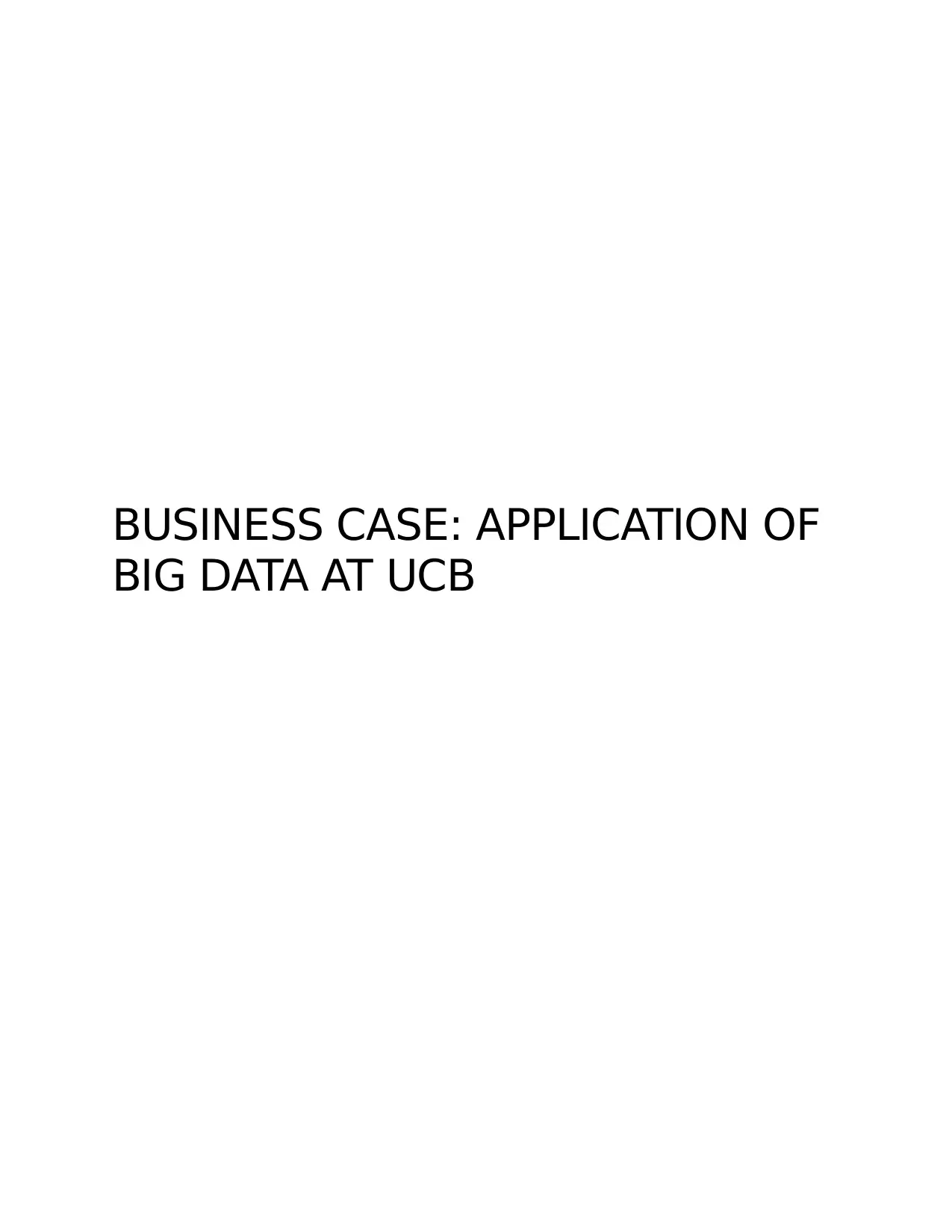
BUSINESS CASE: APPLICATION OF
BIG DATA AT UCB
BIG DATA AT UCB
Paraphrase This Document
Need a fresh take? Get an instant paraphrase of this document with our AI Paraphraser
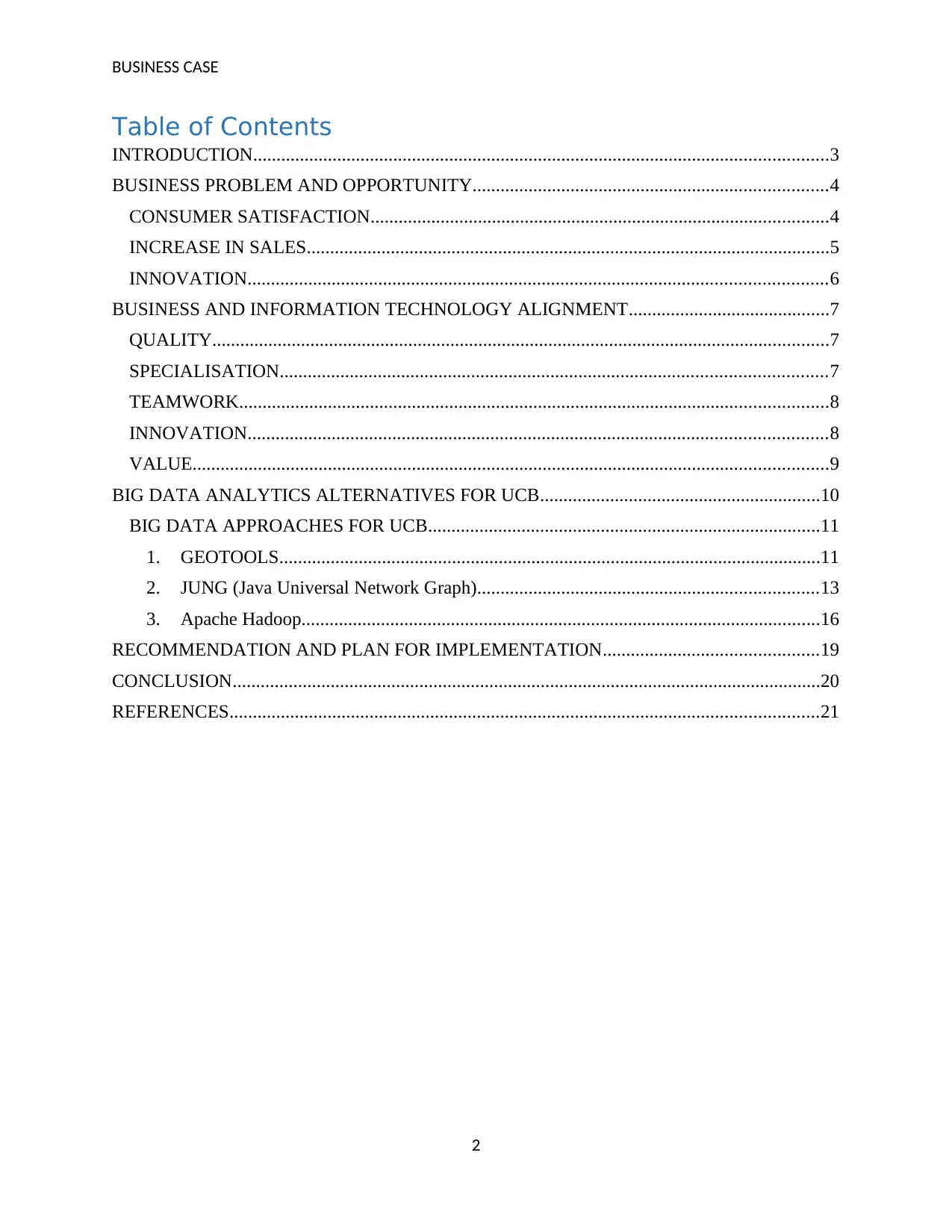
BUSINESS CASE
Table of Contents
INTRODUCTION...........................................................................................................................3
BUSINESS PROBLEM AND OPPORTUNITY............................................................................4
CONSUMER SATISFACTION..................................................................................................4
INCREASE IN SALES................................................................................................................5
INNOVATION............................................................................................................................6
BUSINESS AND INFORMATION TECHNOLOGY ALIGNMENT...........................................7
QUALITY....................................................................................................................................7
SPECIALISATION.....................................................................................................................7
TEAMWORK..............................................................................................................................8
INNOVATION............................................................................................................................8
VALUE........................................................................................................................................9
BIG DATA ANALYTICS ALTERNATIVES FOR UCB............................................................10
BIG DATA APPROACHES FOR UCB....................................................................................11
1. GEOTOOLS....................................................................................................................11
2. JUNG (Java Universal Network Graph).........................................................................13
3. Apache Hadoop...............................................................................................................16
RECOMMENDATION AND PLAN FOR IMPLEMENTATION..............................................19
CONCLUSION..............................................................................................................................20
REFERENCES..............................................................................................................................21
2
Table of Contents
INTRODUCTION...........................................................................................................................3
BUSINESS PROBLEM AND OPPORTUNITY............................................................................4
CONSUMER SATISFACTION..................................................................................................4
INCREASE IN SALES................................................................................................................5
INNOVATION............................................................................................................................6
BUSINESS AND INFORMATION TECHNOLOGY ALIGNMENT...........................................7
QUALITY....................................................................................................................................7
SPECIALISATION.....................................................................................................................7
TEAMWORK..............................................................................................................................8
INNOVATION............................................................................................................................8
VALUE........................................................................................................................................9
BIG DATA ANALYTICS ALTERNATIVES FOR UCB............................................................10
BIG DATA APPROACHES FOR UCB....................................................................................11
1. GEOTOOLS....................................................................................................................11
2. JUNG (Java Universal Network Graph).........................................................................13
3. Apache Hadoop...............................................................................................................16
RECOMMENDATION AND PLAN FOR IMPLEMENTATION..............................................19
CONCLUSION..............................................................................................................................20
REFERENCES..............................................................................................................................21
2
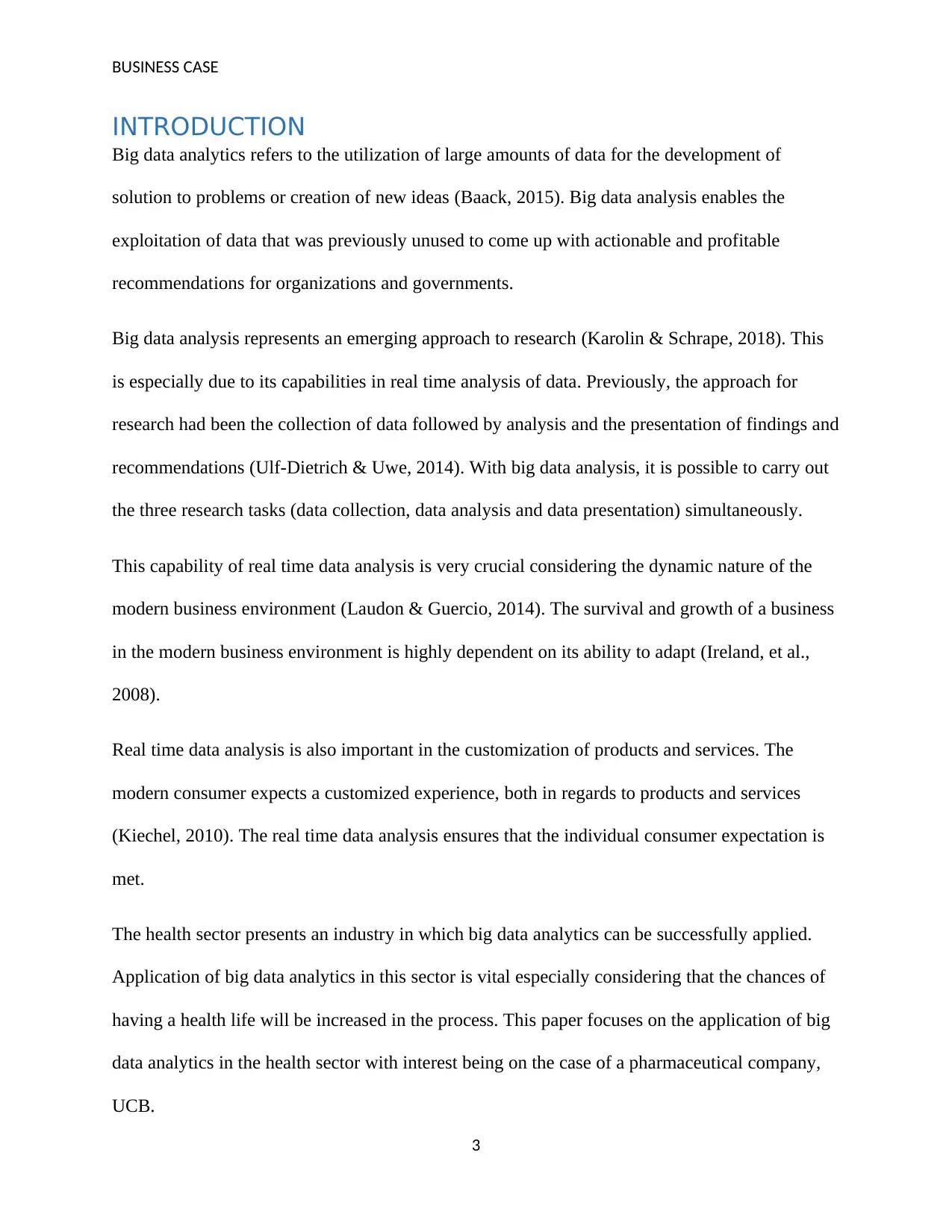
BUSINESS CASE
INTRODUCTION
Big data analytics refers to the utilization of large amounts of data for the development of
solution to problems or creation of new ideas (Baack, 2015). Big data analysis enables the
exploitation of data that was previously unused to come up with actionable and profitable
recommendations for organizations and governments.
Big data analysis represents an emerging approach to research (Karolin & Schrape, 2018). This
is especially due to its capabilities in real time analysis of data. Previously, the approach for
research had been the collection of data followed by analysis and the presentation of findings and
recommendations (Ulf-Dietrich & Uwe, 2014). With big data analysis, it is possible to carry out
the three research tasks (data collection, data analysis and data presentation) simultaneously.
This capability of real time data analysis is very crucial considering the dynamic nature of the
modern business environment (Laudon & Guercio, 2014). The survival and growth of a business
in the modern business environment is highly dependent on its ability to adapt (Ireland, et al.,
2008).
Real time data analysis is also important in the customization of products and services. The
modern consumer expects a customized experience, both in regards to products and services
(Kiechel, 2010). The real time data analysis ensures that the individual consumer expectation is
met.
The health sector presents an industry in which big data analytics can be successfully applied.
Application of big data analytics in this sector is vital especially considering that the chances of
having a health life will be increased in the process. This paper focuses on the application of big
data analytics in the health sector with interest being on the case of a pharmaceutical company,
UCB.
3
INTRODUCTION
Big data analytics refers to the utilization of large amounts of data for the development of
solution to problems or creation of new ideas (Baack, 2015). Big data analysis enables the
exploitation of data that was previously unused to come up with actionable and profitable
recommendations for organizations and governments.
Big data analysis represents an emerging approach to research (Karolin & Schrape, 2018). This
is especially due to its capabilities in real time analysis of data. Previously, the approach for
research had been the collection of data followed by analysis and the presentation of findings and
recommendations (Ulf-Dietrich & Uwe, 2014). With big data analysis, it is possible to carry out
the three research tasks (data collection, data analysis and data presentation) simultaneously.
This capability of real time data analysis is very crucial considering the dynamic nature of the
modern business environment (Laudon & Guercio, 2014). The survival and growth of a business
in the modern business environment is highly dependent on its ability to adapt (Ireland, et al.,
2008).
Real time data analysis is also important in the customization of products and services. The
modern consumer expects a customized experience, both in regards to products and services
(Kiechel, 2010). The real time data analysis ensures that the individual consumer expectation is
met.
The health sector presents an industry in which big data analytics can be successfully applied.
Application of big data analytics in this sector is vital especially considering that the chances of
having a health life will be increased in the process. This paper focuses on the application of big
data analytics in the health sector with interest being on the case of a pharmaceutical company,
UCB.
3
⊘ This is a preview!⊘
Do you want full access?
Subscribe today to unlock all pages.

Trusted by 1+ million students worldwide
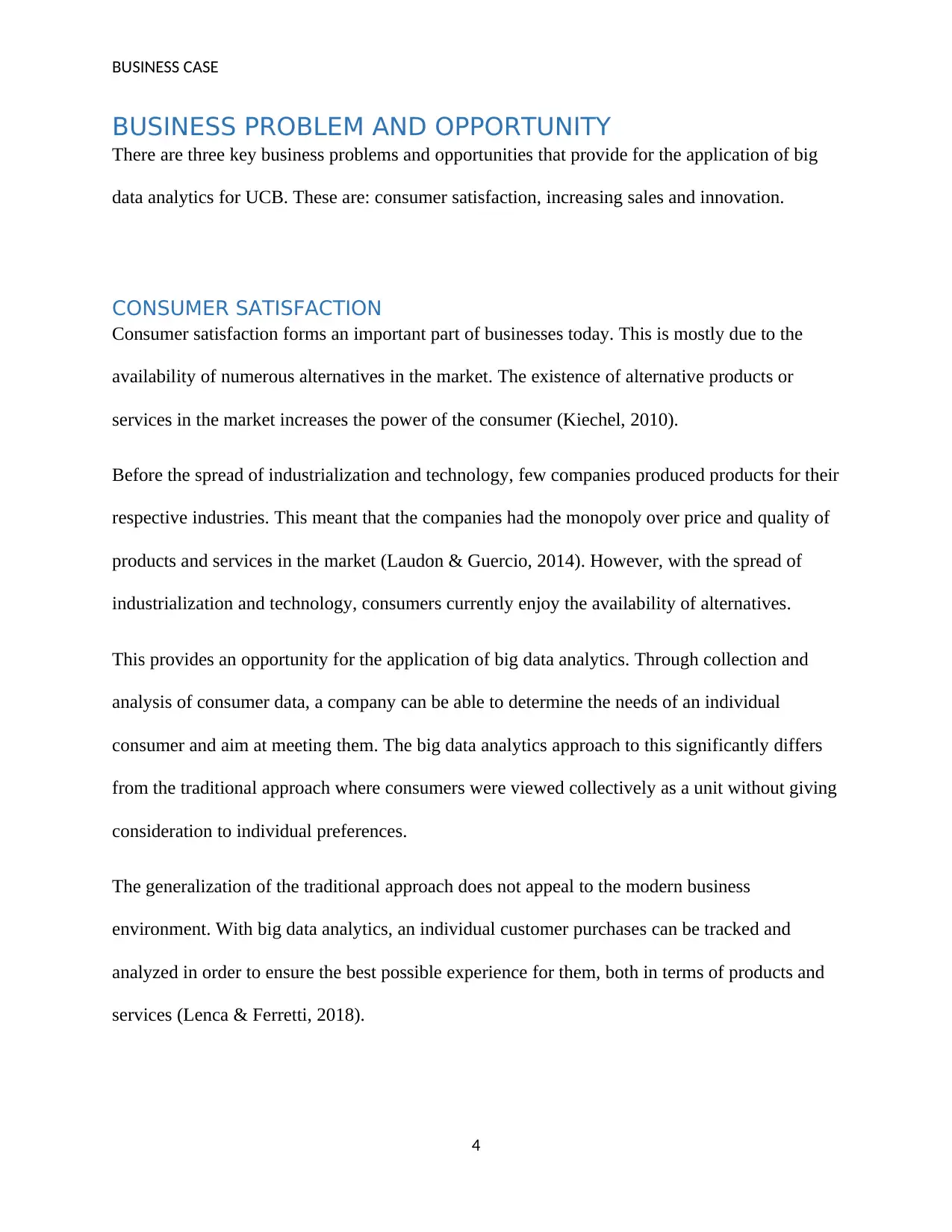
BUSINESS CASE
BUSINESS PROBLEM AND OPPORTUNITY
There are three key business problems and opportunities that provide for the application of big
data analytics for UCB. These are: consumer satisfaction, increasing sales and innovation.
CONSUMER SATISFACTION
Consumer satisfaction forms an important part of businesses today. This is mostly due to the
availability of numerous alternatives in the market. The existence of alternative products or
services in the market increases the power of the consumer (Kiechel, 2010).
Before the spread of industrialization and technology, few companies produced products for their
respective industries. This meant that the companies had the monopoly over price and quality of
products and services in the market (Laudon & Guercio, 2014). However, with the spread of
industrialization and technology, consumers currently enjoy the availability of alternatives.
This provides an opportunity for the application of big data analytics. Through collection and
analysis of consumer data, a company can be able to determine the needs of an individual
consumer and aim at meeting them. The big data analytics approach to this significantly differs
from the traditional approach where consumers were viewed collectively as a unit without giving
consideration to individual preferences.
The generalization of the traditional approach does not appeal to the modern business
environment. With big data analytics, an individual customer purchases can be tracked and
analyzed in order to ensure the best possible experience for them, both in terms of products and
services (Lenca & Ferretti, 2018).
4
BUSINESS PROBLEM AND OPPORTUNITY
There are three key business problems and opportunities that provide for the application of big
data analytics for UCB. These are: consumer satisfaction, increasing sales and innovation.
CONSUMER SATISFACTION
Consumer satisfaction forms an important part of businesses today. This is mostly due to the
availability of numerous alternatives in the market. The existence of alternative products or
services in the market increases the power of the consumer (Kiechel, 2010).
Before the spread of industrialization and technology, few companies produced products for their
respective industries. This meant that the companies had the monopoly over price and quality of
products and services in the market (Laudon & Guercio, 2014). However, with the spread of
industrialization and technology, consumers currently enjoy the availability of alternatives.
This provides an opportunity for the application of big data analytics. Through collection and
analysis of consumer data, a company can be able to determine the needs of an individual
consumer and aim at meeting them. The big data analytics approach to this significantly differs
from the traditional approach where consumers were viewed collectively as a unit without giving
consideration to individual preferences.
The generalization of the traditional approach does not appeal to the modern business
environment. With big data analytics, an individual customer purchases can be tracked and
analyzed in order to ensure the best possible experience for them, both in terms of products and
services (Lenca & Ferretti, 2018).
4
Paraphrase This Document
Need a fresh take? Get an instant paraphrase of this document with our AI Paraphraser
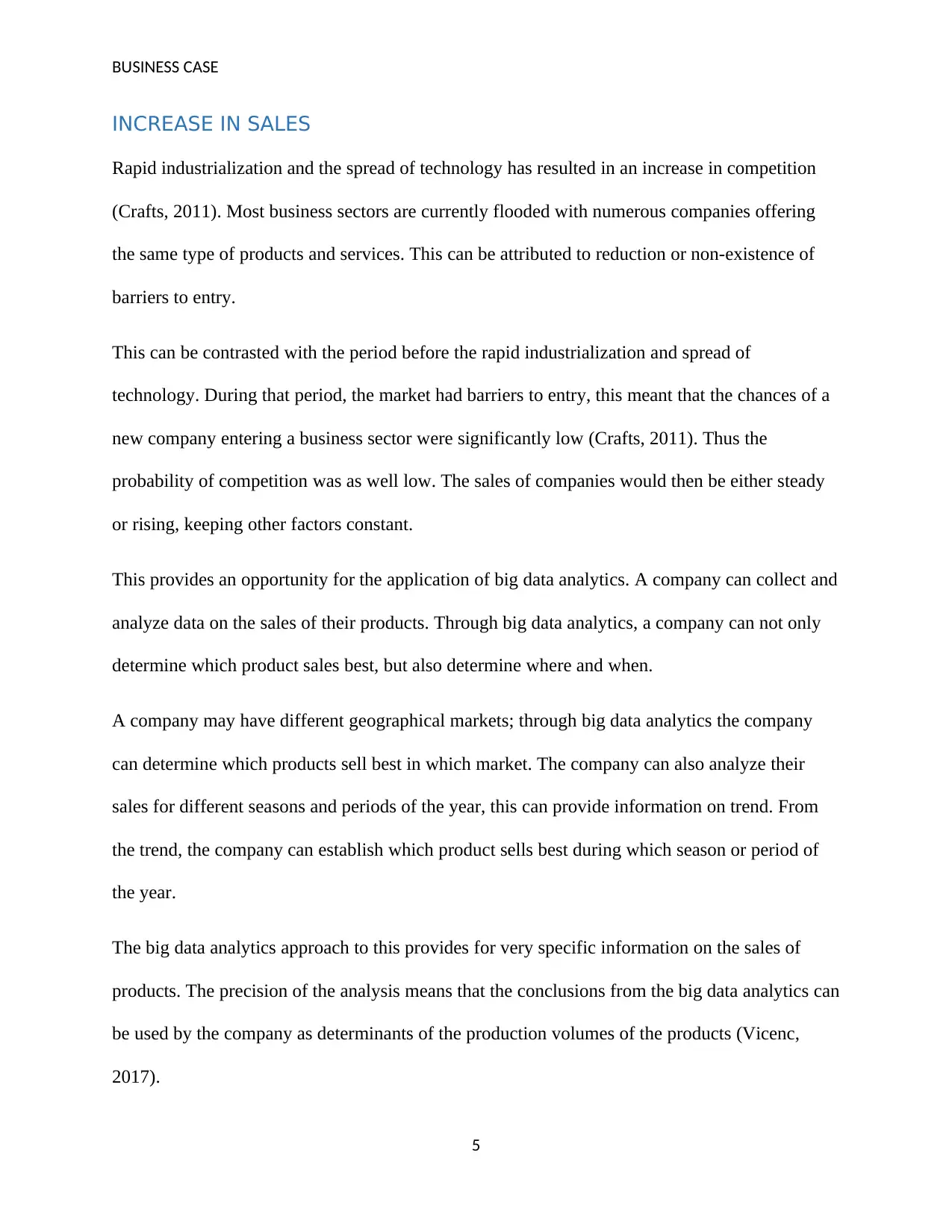
BUSINESS CASE
INCREASE IN SALES
Rapid industrialization and the spread of technology has resulted in an increase in competition
(Crafts, 2011). Most business sectors are currently flooded with numerous companies offering
the same type of products and services. This can be attributed to reduction or non-existence of
barriers to entry.
This can be contrasted with the period before the rapid industrialization and spread of
technology. During that period, the market had barriers to entry, this meant that the chances of a
new company entering a business sector were significantly low (Crafts, 2011). Thus the
probability of competition was as well low. The sales of companies would then be either steady
or rising, keeping other factors constant.
This provides an opportunity for the application of big data analytics. A company can collect and
analyze data on the sales of their products. Through big data analytics, a company can not only
determine which product sales best, but also determine where and when.
A company may have different geographical markets; through big data analytics the company
can determine which products sell best in which market. The company can also analyze their
sales for different seasons and periods of the year, this can provide information on trend. From
the trend, the company can establish which product sells best during which season or period of
the year.
The big data analytics approach to this provides for very specific information on the sales of
products. The precision of the analysis means that the conclusions from the big data analytics can
be used by the company as determinants of the production volumes of the products (Vicenc,
2017).
5
INCREASE IN SALES
Rapid industrialization and the spread of technology has resulted in an increase in competition
(Crafts, 2011). Most business sectors are currently flooded with numerous companies offering
the same type of products and services. This can be attributed to reduction or non-existence of
barriers to entry.
This can be contrasted with the period before the rapid industrialization and spread of
technology. During that period, the market had barriers to entry, this meant that the chances of a
new company entering a business sector were significantly low (Crafts, 2011). Thus the
probability of competition was as well low. The sales of companies would then be either steady
or rising, keeping other factors constant.
This provides an opportunity for the application of big data analytics. A company can collect and
analyze data on the sales of their products. Through big data analytics, a company can not only
determine which product sales best, but also determine where and when.
A company may have different geographical markets; through big data analytics the company
can determine which products sell best in which market. The company can also analyze their
sales for different seasons and periods of the year, this can provide information on trend. From
the trend, the company can establish which product sells best during which season or period of
the year.
The big data analytics approach to this provides for very specific information on the sales of
products. The precision of the analysis means that the conclusions from the big data analytics can
be used by the company as determinants of the production volumes of the products (Vicenc,
2017).
5
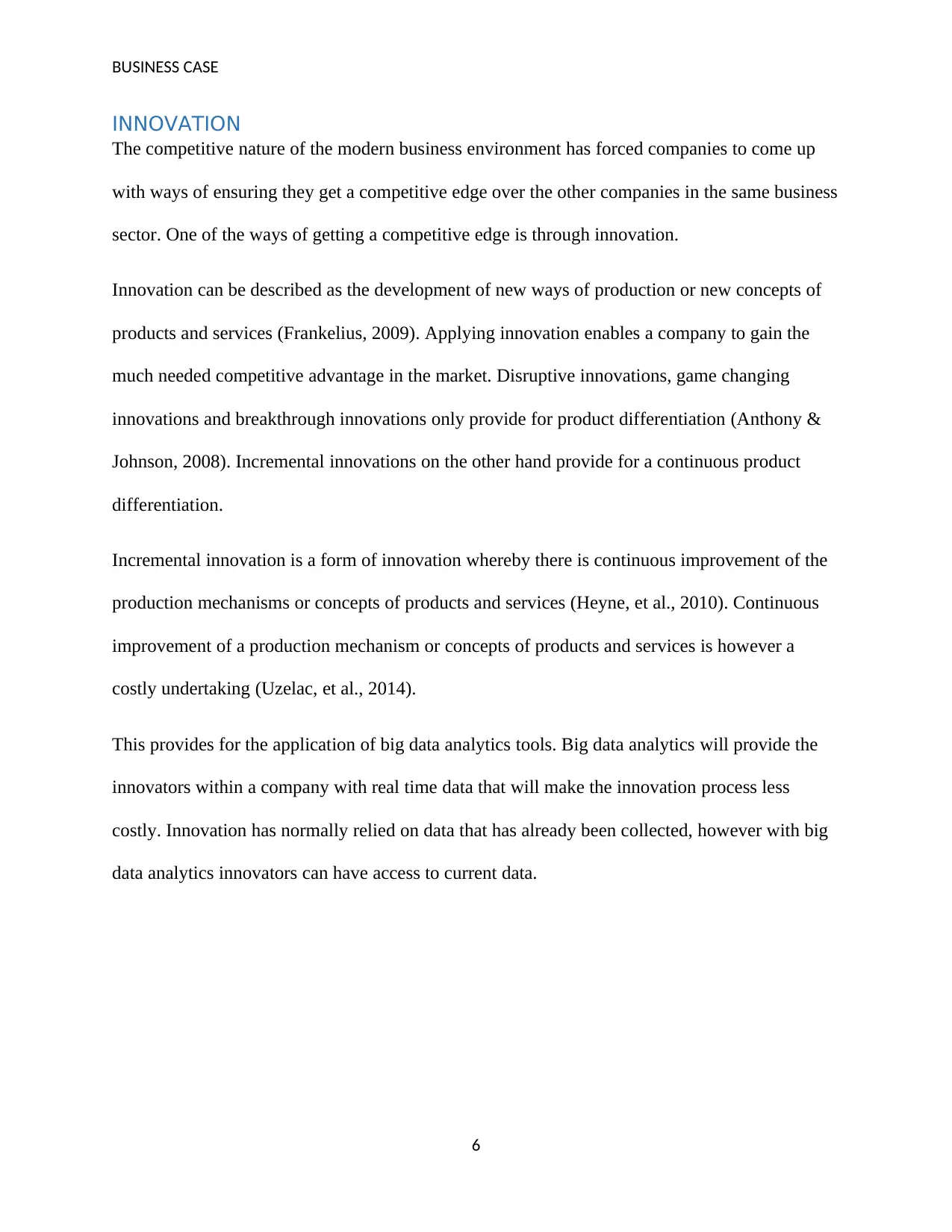
BUSINESS CASE
INNOVATION
The competitive nature of the modern business environment has forced companies to come up
with ways of ensuring they get a competitive edge over the other companies in the same business
sector. One of the ways of getting a competitive edge is through innovation.
Innovation can be described as the development of new ways of production or new concepts of
products and services (Frankelius, 2009). Applying innovation enables a company to gain the
much needed competitive advantage in the market. Disruptive innovations, game changing
innovations and breakthrough innovations only provide for product differentiation (Anthony &
Johnson, 2008). Incremental innovations on the other hand provide for a continuous product
differentiation.
Incremental innovation is a form of innovation whereby there is continuous improvement of the
production mechanisms or concepts of products and services (Heyne, et al., 2010). Continuous
improvement of a production mechanism or concepts of products and services is however a
costly undertaking (Uzelac, et al., 2014).
This provides for the application of big data analytics tools. Big data analytics will provide the
innovators within a company with real time data that will make the innovation process less
costly. Innovation has normally relied on data that has already been collected, however with big
data analytics innovators can have access to current data.
6
INNOVATION
The competitive nature of the modern business environment has forced companies to come up
with ways of ensuring they get a competitive edge over the other companies in the same business
sector. One of the ways of getting a competitive edge is through innovation.
Innovation can be described as the development of new ways of production or new concepts of
products and services (Frankelius, 2009). Applying innovation enables a company to gain the
much needed competitive advantage in the market. Disruptive innovations, game changing
innovations and breakthrough innovations only provide for product differentiation (Anthony &
Johnson, 2008). Incremental innovations on the other hand provide for a continuous product
differentiation.
Incremental innovation is a form of innovation whereby there is continuous improvement of the
production mechanisms or concepts of products and services (Heyne, et al., 2010). Continuous
improvement of a production mechanism or concepts of products and services is however a
costly undertaking (Uzelac, et al., 2014).
This provides for the application of big data analytics tools. Big data analytics will provide the
innovators within a company with real time data that will make the innovation process less
costly. Innovation has normally relied on data that has already been collected, however with big
data analytics innovators can have access to current data.
6
⊘ This is a preview!⊘
Do you want full access?
Subscribe today to unlock all pages.

Trusted by 1+ million students worldwide
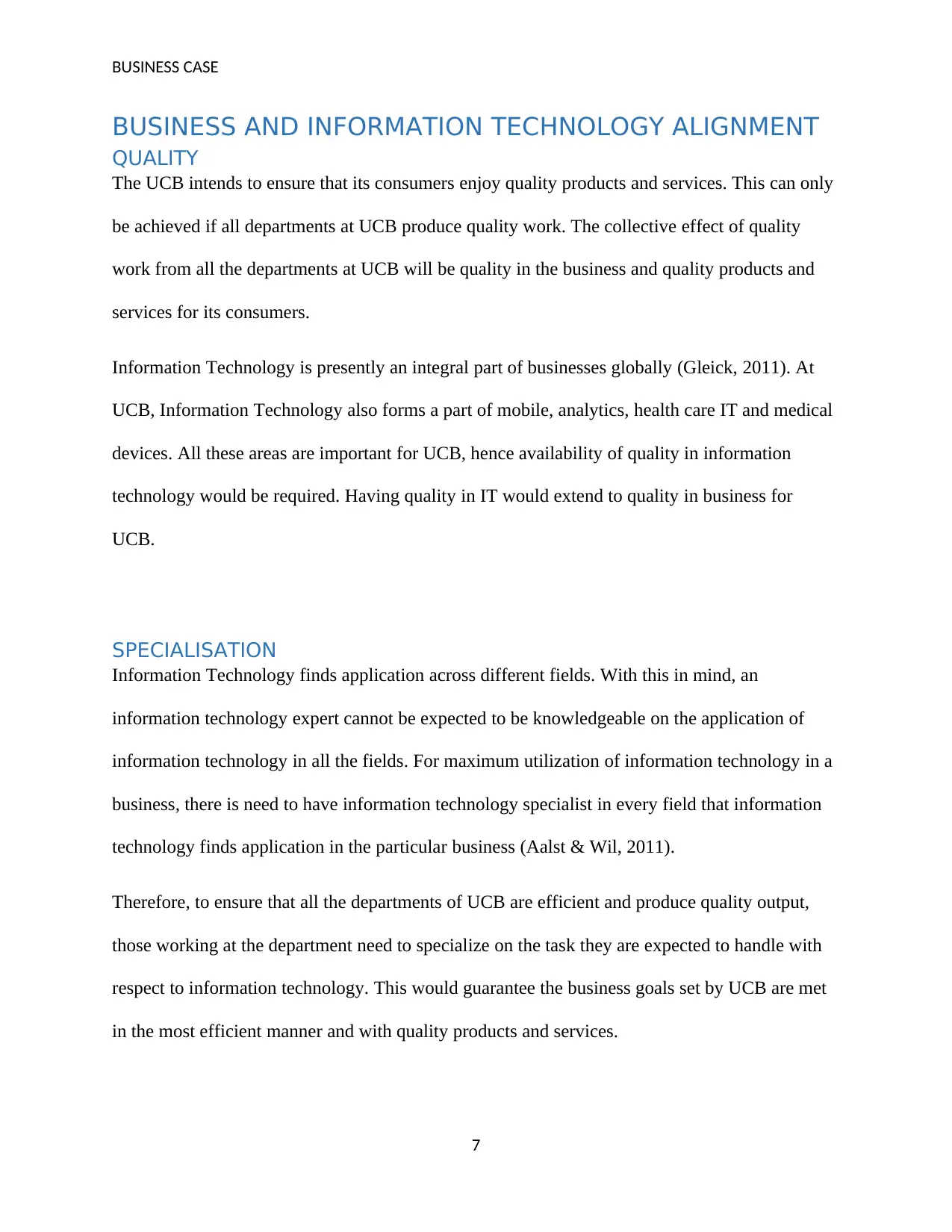
BUSINESS CASE
BUSINESS AND INFORMATION TECHNOLOGY ALIGNMENT
QUALITY
The UCB intends to ensure that its consumers enjoy quality products and services. This can only
be achieved if all departments at UCB produce quality work. The collective effect of quality
work from all the departments at UCB will be quality in the business and quality products and
services for its consumers.
Information Technology is presently an integral part of businesses globally (Gleick, 2011). At
UCB, Information Technology also forms a part of mobile, analytics, health care IT and medical
devices. All these areas are important for UCB, hence availability of quality in information
technology would be required. Having quality in IT would extend to quality in business for
UCB.
SPECIALISATION
Information Technology finds application across different fields. With this in mind, an
information technology expert cannot be expected to be knowledgeable on the application of
information technology in all the fields. For maximum utilization of information technology in a
business, there is need to have information technology specialist in every field that information
technology finds application in the particular business (Aalst & Wil, 2011).
Therefore, to ensure that all the departments of UCB are efficient and produce quality output,
those working at the department need to specialize on the task they are expected to handle with
respect to information technology. This would guarantee the business goals set by UCB are met
in the most efficient manner and with quality products and services.
7
BUSINESS AND INFORMATION TECHNOLOGY ALIGNMENT
QUALITY
The UCB intends to ensure that its consumers enjoy quality products and services. This can only
be achieved if all departments at UCB produce quality work. The collective effect of quality
work from all the departments at UCB will be quality in the business and quality products and
services for its consumers.
Information Technology is presently an integral part of businesses globally (Gleick, 2011). At
UCB, Information Technology also forms a part of mobile, analytics, health care IT and medical
devices. All these areas are important for UCB, hence availability of quality in information
technology would be required. Having quality in IT would extend to quality in business for
UCB.
SPECIALISATION
Information Technology finds application across different fields. With this in mind, an
information technology expert cannot be expected to be knowledgeable on the application of
information technology in all the fields. For maximum utilization of information technology in a
business, there is need to have information technology specialist in every field that information
technology finds application in the particular business (Aalst & Wil, 2011).
Therefore, to ensure that all the departments of UCB are efficient and produce quality output,
those working at the department need to specialize on the task they are expected to handle with
respect to information technology. This would guarantee the business goals set by UCB are met
in the most efficient manner and with quality products and services.
7
Paraphrase This Document
Need a fresh take? Get an instant paraphrase of this document with our AI Paraphraser
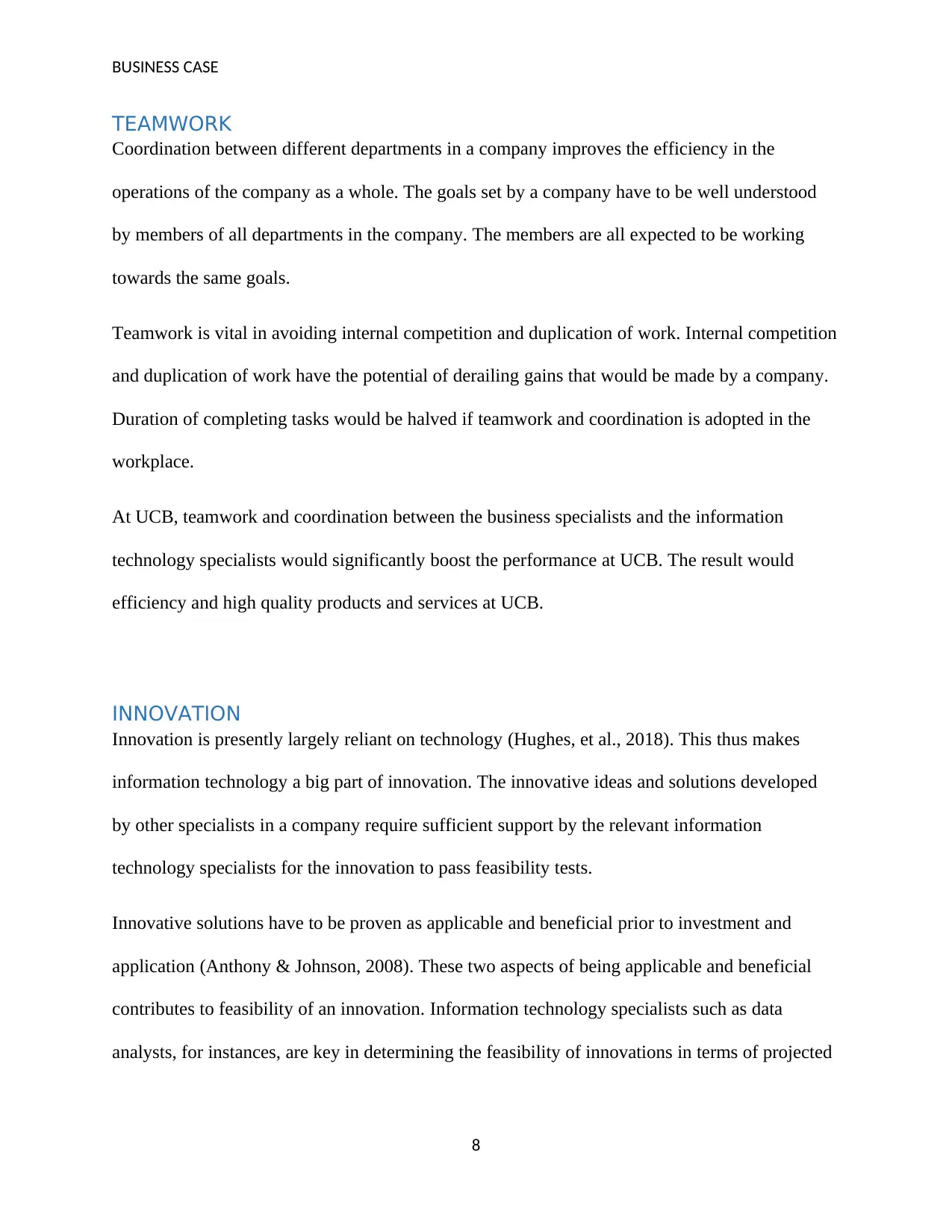
BUSINESS CASE
TEAMWORK
Coordination between different departments in a company improves the efficiency in the
operations of the company as a whole. The goals set by a company have to be well understood
by members of all departments in the company. The members are all expected to be working
towards the same goals.
Teamwork is vital in avoiding internal competition and duplication of work. Internal competition
and duplication of work have the potential of derailing gains that would be made by a company.
Duration of completing tasks would be halved if teamwork and coordination is adopted in the
workplace.
At UCB, teamwork and coordination between the business specialists and the information
technology specialists would significantly boost the performance at UCB. The result would
efficiency and high quality products and services at UCB.
INNOVATION
Innovation is presently largely reliant on technology (Hughes, et al., 2018). This thus makes
information technology a big part of innovation. The innovative ideas and solutions developed
by other specialists in a company require sufficient support by the relevant information
technology specialists for the innovation to pass feasibility tests.
Innovative solutions have to be proven as applicable and beneficial prior to investment and
application (Anthony & Johnson, 2008). These two aspects of being applicable and beneficial
contributes to feasibility of an innovation. Information technology specialists such as data
analysts, for instances, are key in determining the feasibility of innovations in terms of projected
8
TEAMWORK
Coordination between different departments in a company improves the efficiency in the
operations of the company as a whole. The goals set by a company have to be well understood
by members of all departments in the company. The members are all expected to be working
towards the same goals.
Teamwork is vital in avoiding internal competition and duplication of work. Internal competition
and duplication of work have the potential of derailing gains that would be made by a company.
Duration of completing tasks would be halved if teamwork and coordination is adopted in the
workplace.
At UCB, teamwork and coordination between the business specialists and the information
technology specialists would significantly boost the performance at UCB. The result would
efficiency and high quality products and services at UCB.
INNOVATION
Innovation is presently largely reliant on technology (Hughes, et al., 2018). This thus makes
information technology a big part of innovation. The innovative ideas and solutions developed
by other specialists in a company require sufficient support by the relevant information
technology specialists for the innovation to pass feasibility tests.
Innovative solutions have to be proven as applicable and beneficial prior to investment and
application (Anthony & Johnson, 2008). These two aspects of being applicable and beneficial
contributes to feasibility of an innovation. Information technology specialists such as data
analysts, for instances, are key in determining the feasibility of innovations in terms of projected
8
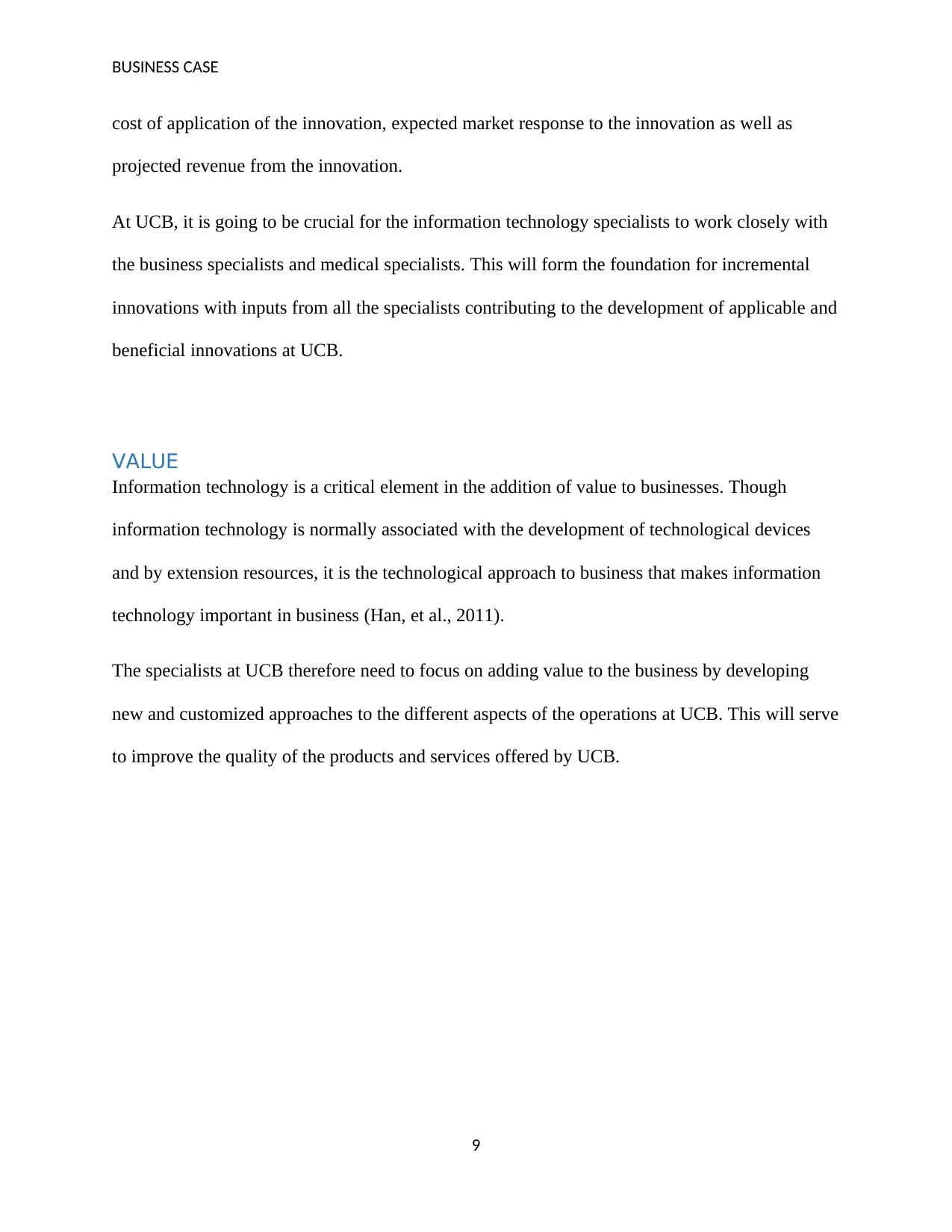
BUSINESS CASE
cost of application of the innovation, expected market response to the innovation as well as
projected revenue from the innovation.
At UCB, it is going to be crucial for the information technology specialists to work closely with
the business specialists and medical specialists. This will form the foundation for incremental
innovations with inputs from all the specialists contributing to the development of applicable and
beneficial innovations at UCB.
VALUE
Information technology is a critical element in the addition of value to businesses. Though
information technology is normally associated with the development of technological devices
and by extension resources, it is the technological approach to business that makes information
technology important in business (Han, et al., 2011).
The specialists at UCB therefore need to focus on adding value to the business by developing
new and customized approaches to the different aspects of the operations at UCB. This will serve
to improve the quality of the products and services offered by UCB.
9
cost of application of the innovation, expected market response to the innovation as well as
projected revenue from the innovation.
At UCB, it is going to be crucial for the information technology specialists to work closely with
the business specialists and medical specialists. This will form the foundation for incremental
innovations with inputs from all the specialists contributing to the development of applicable and
beneficial innovations at UCB.
VALUE
Information technology is a critical element in the addition of value to businesses. Though
information technology is normally associated with the development of technological devices
and by extension resources, it is the technological approach to business that makes information
technology important in business (Han, et al., 2011).
The specialists at UCB therefore need to focus on adding value to the business by developing
new and customized approaches to the different aspects of the operations at UCB. This will serve
to improve the quality of the products and services offered by UCB.
9
⊘ This is a preview!⊘
Do you want full access?
Subscribe today to unlock all pages.

Trusted by 1+ million students worldwide
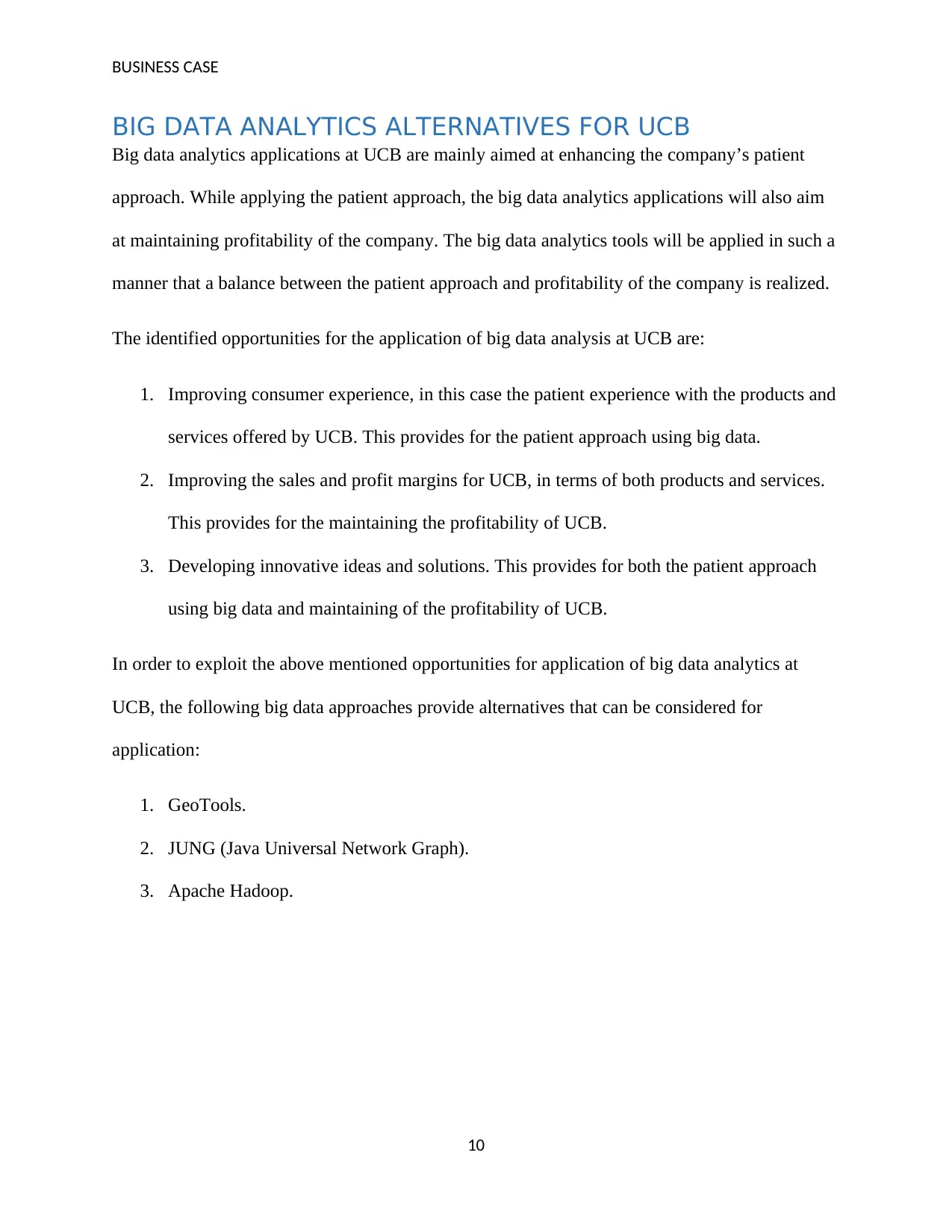
BUSINESS CASE
BIG DATA ANALYTICS ALTERNATIVES FOR UCB
Big data analytics applications at UCB are mainly aimed at enhancing the company’s patient
approach. While applying the patient approach, the big data analytics applications will also aim
at maintaining profitability of the company. The big data analytics tools will be applied in such a
manner that a balance between the patient approach and profitability of the company is realized.
The identified opportunities for the application of big data analysis at UCB are:
1. Improving consumer experience, in this case the patient experience with the products and
services offered by UCB. This provides for the patient approach using big data.
2. Improving the sales and profit margins for UCB, in terms of both products and services.
This provides for the maintaining the profitability of UCB.
3. Developing innovative ideas and solutions. This provides for both the patient approach
using big data and maintaining of the profitability of UCB.
In order to exploit the above mentioned opportunities for application of big data analytics at
UCB, the following big data approaches provide alternatives that can be considered for
application:
1. GeoTools.
2. JUNG (Java Universal Network Graph).
3. Apache Hadoop.
10
BIG DATA ANALYTICS ALTERNATIVES FOR UCB
Big data analytics applications at UCB are mainly aimed at enhancing the company’s patient
approach. While applying the patient approach, the big data analytics applications will also aim
at maintaining profitability of the company. The big data analytics tools will be applied in such a
manner that a balance between the patient approach and profitability of the company is realized.
The identified opportunities for the application of big data analysis at UCB are:
1. Improving consumer experience, in this case the patient experience with the products and
services offered by UCB. This provides for the patient approach using big data.
2. Improving the sales and profit margins for UCB, in terms of both products and services.
This provides for the maintaining the profitability of UCB.
3. Developing innovative ideas and solutions. This provides for both the patient approach
using big data and maintaining of the profitability of UCB.
In order to exploit the above mentioned opportunities for application of big data analytics at
UCB, the following big data approaches provide alternatives that can be considered for
application:
1. GeoTools.
2. JUNG (Java Universal Network Graph).
3. Apache Hadoop.
10
Paraphrase This Document
Need a fresh take? Get an instant paraphrase of this document with our AI Paraphraser
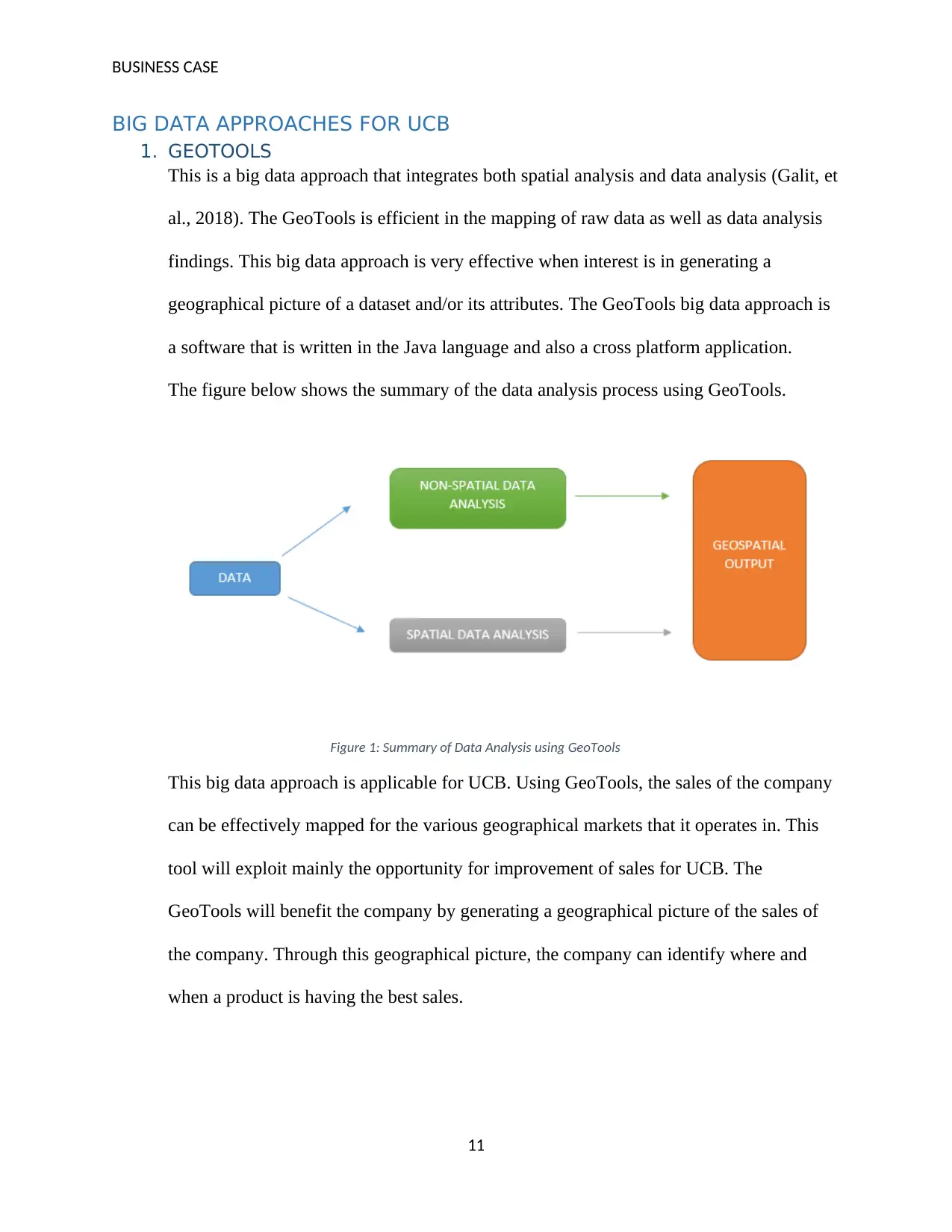
BUSINESS CASE
BIG DATA APPROACHES FOR UCB
1. GEOTOOLS
This is a big data approach that integrates both spatial analysis and data analysis (Galit, et
al., 2018). The GeoTools is efficient in the mapping of raw data as well as data analysis
findings. This big data approach is very effective when interest is in generating a
geographical picture of a dataset and/or its attributes. The GeoTools big data approach is
a software that is written in the Java language and also a cross platform application.
The figure below shows the summary of the data analysis process using GeoTools.
Figure 1: Summary of Data Analysis using GeoTools
This big data approach is applicable for UCB. Using GeoTools, the sales of the company
can be effectively mapped for the various geographical markets that it operates in. This
tool will exploit mainly the opportunity for improvement of sales for UCB. The
GeoTools will benefit the company by generating a geographical picture of the sales of
the company. Through this geographical picture, the company can identify where and
when a product is having the best sales.
11
BIG DATA APPROACHES FOR UCB
1. GEOTOOLS
This is a big data approach that integrates both spatial analysis and data analysis (Galit, et
al., 2018). The GeoTools is efficient in the mapping of raw data as well as data analysis
findings. This big data approach is very effective when interest is in generating a
geographical picture of a dataset and/or its attributes. The GeoTools big data approach is
a software that is written in the Java language and also a cross platform application.
The figure below shows the summary of the data analysis process using GeoTools.
Figure 1: Summary of Data Analysis using GeoTools
This big data approach is applicable for UCB. Using GeoTools, the sales of the company
can be effectively mapped for the various geographical markets that it operates in. This
tool will exploit mainly the opportunity for improvement of sales for UCB. The
GeoTools will benefit the company by generating a geographical picture of the sales of
the company. Through this geographical picture, the company can identify where and
when a product is having the best sales.
11
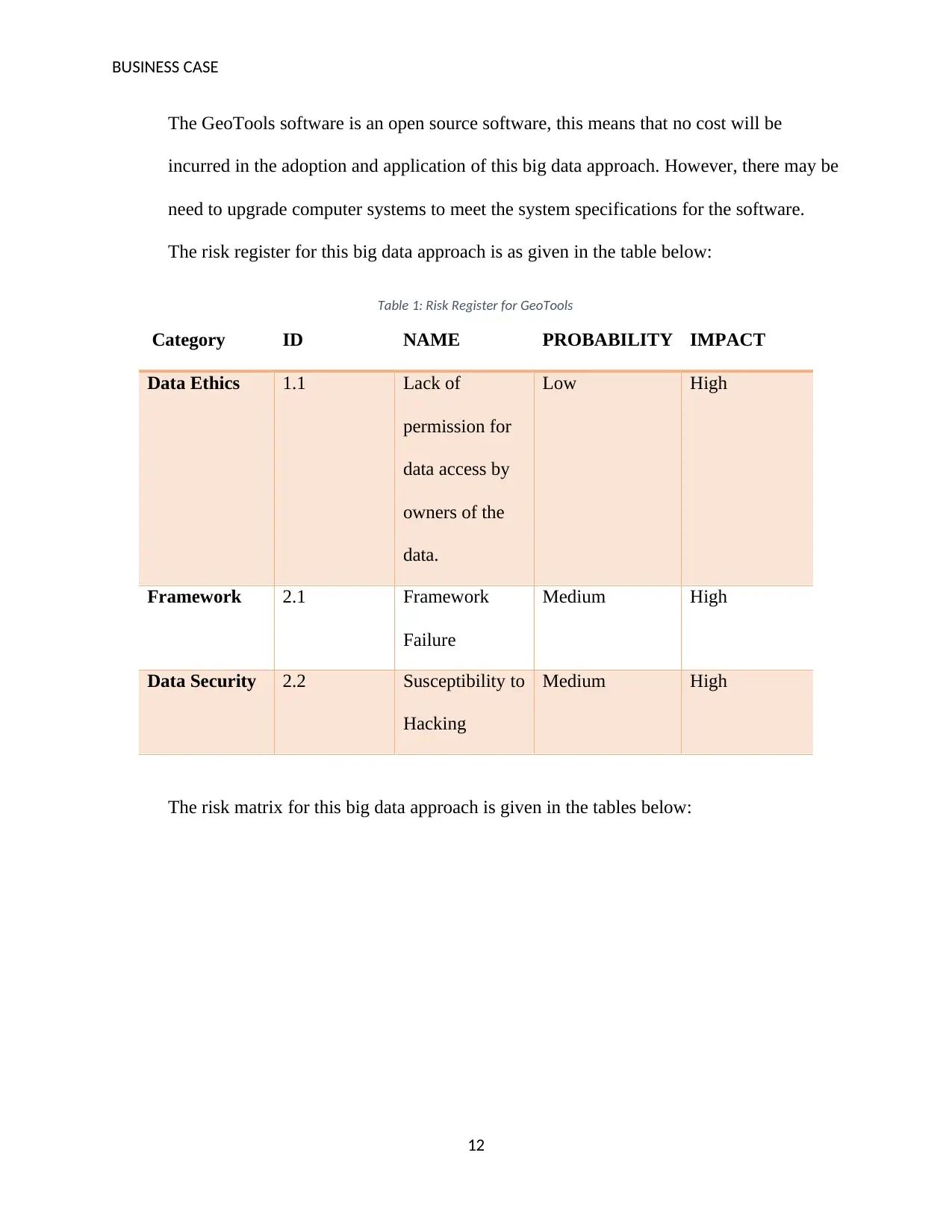
BUSINESS CASE
The GeoTools software is an open source software, this means that no cost will be
incurred in the adoption and application of this big data approach. However, there may be
need to upgrade computer systems to meet the system specifications for the software.
The risk register for this big data approach is as given in the table below:
Table 1: Risk Register for GeoTools
Category ID NAME PROBABILITY IMPACT
Data Ethics 1.1 Lack of
permission for
data access by
owners of the
data.
Low High
Framework 2.1 Framework
Failure
Medium High
Data Security 2.2 Susceptibility to
Hacking
Medium High
The risk matrix for this big data approach is given in the tables below:
12
The GeoTools software is an open source software, this means that no cost will be
incurred in the adoption and application of this big data approach. However, there may be
need to upgrade computer systems to meet the system specifications for the software.
The risk register for this big data approach is as given in the table below:
Table 1: Risk Register for GeoTools
Category ID NAME PROBABILITY IMPACT
Data Ethics 1.1 Lack of
permission for
data access by
owners of the
data.
Low High
Framework 2.1 Framework
Failure
Medium High
Data Security 2.2 Susceptibility to
Hacking
Medium High
The risk matrix for this big data approach is given in the tables below:
12
⊘ This is a preview!⊘
Do you want full access?
Subscribe today to unlock all pages.

Trusted by 1+ million students worldwide
1 out of 24
Related Documents
Your All-in-One AI-Powered Toolkit for Academic Success.
+13062052269
info@desklib.com
Available 24*7 on WhatsApp / Email
![[object Object]](/_next/static/media/star-bottom.7253800d.svg)
Unlock your academic potential
Copyright © 2020–2025 A2Z Services. All Rights Reserved. Developed and managed by ZUCOL.





